The 2015 MacBook Review
by Ryan Smith on April 14, 2015 10:15 AM ESTThe MacBook’s Retina Display: Pro Quality
One of the long-standing demands for Apple’s MacBook Air line has been for an IPS, Retina-density display for Apple’s light laptops. After introducing Retina-style displays on the MacBook Pro, iPad, iPhone, and iMac, the Air was the last product without a Retina display. However at the same time the Air was also simultaneously Apple’s entry-level laptop and their ultra-portable laptop, so adding a Retina display to the Air has always faced the needs of balancing cost and technical considerations against consumer demand.
As it turns out the Air isn’t getting a Retina display (at least not this year), but Apple is going all-in on the more premium MacBook, Retina display, integrated cover glass, and all. From a cost perspective this isn’t all that surprising, but from a technical perspective it means Apple has needed to address the technical cost of going Retina.
Starting from the top, the MacBook ships with a 12” IPS Retina display. The display’s native resolution is an uncommon 2304 x 1440, which is essentially a 16:10 version of the more common 16:9 1440p. With Apple essentially going pro on the MacBook, I’m happy to see a 16:10 display in what’s now Apple’s smallest notebook, increasing the effective size of the display while giving it a more squared design that increases the amount of vertical real-estate versus what a 16:9 display would offer.
The MacBook’s display ends up being 64.72in^2 in size, roughly 13% larger than the MacBook Air 11”. This comes despite the fact that the MacBook occupies a smaller overall footprint than the MBA 11”, showcasing how Apple has been able to increase the screen size while bringing down the overall laptop size. Some of this is ultimately due to geometry from the different aspect ratio, but also Apple has been able to reduce the size of the bezel surrounding the panel, making the panel a larger percentage of the total lid. The MacBook still isn’t something that most people would qualify as an ultra-thin bezel, but coming from the relatively thick MacBook Air it’s quite the change.
Given the display’s native resolution of 2304 x 1440 contained in a 12” panel, this puts the pixel density of the display at 226 PPI, which is virtually identical to the 226 PPI rMBP13 and 220 PPI rMBP15, giving it same density as Apple’s other Retina laptops. Functionally speaking I’d argue that users are going to have their heads a bit closer to the 12” MacBook than they would a larger rMBP, so the effective density is likely still in the rMBP’s favor, but in terms of construction they’re all very similar.
Meanwhile Apple isn’t going into too much detail on the panel other than its size and driving technology (IPS), but they did tell us that the pixels in this panel were designed to have a wider aperture to allow more light out, helping to offset the higher power costs of lighting a Retina display. To that end Apple says that the MacBook’s display is 30% more energy efficient than any other Mac notebook at an equivalent brightness. At this point we’re still trying to identify the panel supplier, as Apple’s tools have not been very forthcoming. A Sharp IGZO panel would traditionally be a good choice for such a power-constrained device, but it’s entirely possible Apple is going with long-time partner LG as well.
Though regardless of the supplier and aperture improvements, as we’ll see in our battery life benchmarks Apple is clearly still having to devote quite a bit of power towards lighting this screen. Thankfully for Apple however just as with the rMBPs, iPhone, and iPad, this is a one-off cost that they don’t have to pay in future generations.
Moving on, as a Retina display Apple offers a range of scaled (virtual) resolutions, with the MacBook’s default resolution serving as a HiDPI version of 1280 x 800. The fact that the scaled resolution is not exactly one-quarter of the display’s physical resolution is an unusual first for an Apple device, but considering the size of the display and power requirements, not to mention the similar PPIs to the rMBPs, I suspect 1280 x 800 scaled on a 2304 x 1440 display was a tradeoff. In any case even without perfect 2:1 scaling Retina-enabled applications look great, and now nearly 3 years after started on Retina in the OS X ecosystem, the number of applications without Retina support are thankfully miniscule.
As far as desktop performance goes, we haven’t found any major problems for the MacBook’s Intel HD Graphics 5300 GPU. Even with Core M’s power limits it doesn’t show any issues holding 60fps at the default virtual resolution of 1280 x 800, though I would not suggest going any higher unless it’s necessary.
Finally, let’s take a look at the MacBook’s display by the numbers. From a design perspective Apple is shipping a pro-quality display, but does the out of the box performance match up with Apple’s high standards?
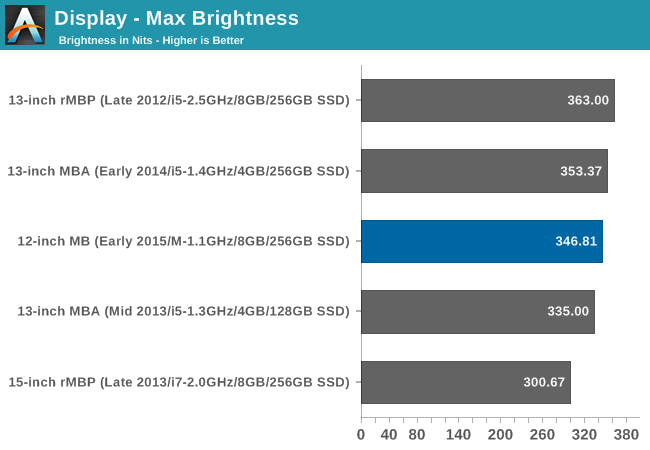
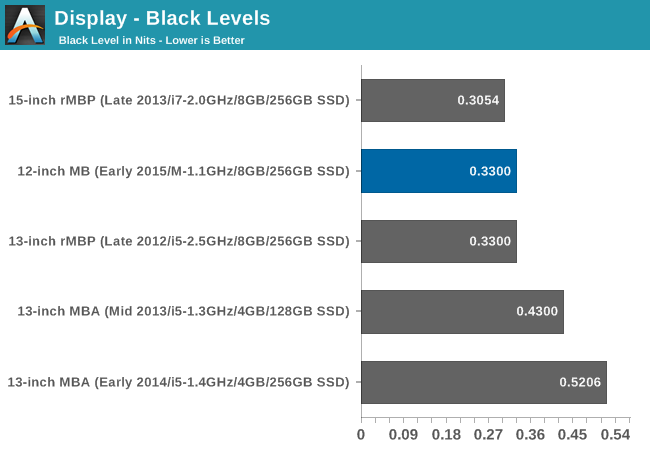
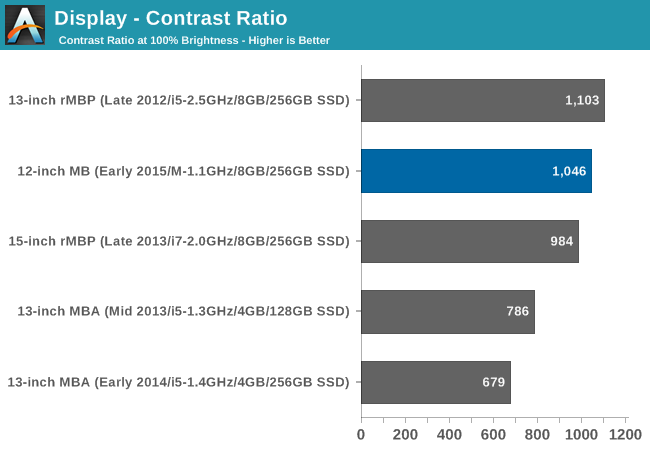
Compared to our most recent MacBooks, the 2015 MacBook delivers contrast performance similar to the Retina MacBook Pros, which is not all that surprising given the shared pixel densities and use of IPS panels among all of these products. Somewhat surprisingly, even with the MacBook’s more limited battery capacity Apple allows the max brightness to go up to 346 nits, in-line with the better-fed rMBPs. At this max brightness setting the black levels work out to 0.33, identical to the 2012 rMBP13. Overall Apple’s black levels tend to be better than average but not fantastic, and the MacBook doesn’t change this.
Otherwise this puts the final contrast ratio at 1046. This is fairly common for HiDPI IPS displays, and though it isn’t chart-topping it’s again right in line with what other Apple laptops do.
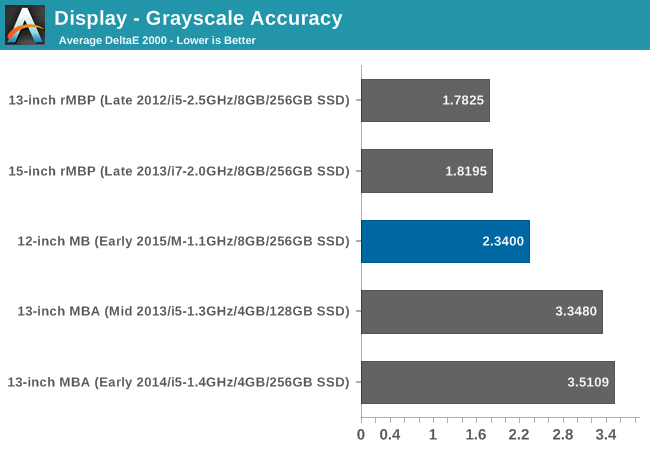
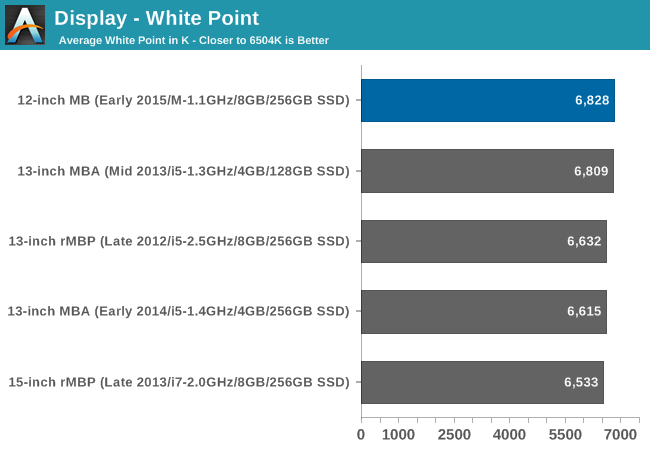
Moving on to accuracy measurements, the MacBook’s greyscale accuracy can’t quite touch the rMBPs, but otherwise at an error of just 2.34 it’s still among the best laptop displays. Even among great PC laptops, out of the box performance below 3 is exceptionally rare.
On the other hand the MacBook’s white point is not quite as good as we’d like to see, and not as good as what the rMBPs can do. The goal here is 6504; the MacBook hits 6828, reflecting the fact that it’s just a bit too red and just a bit too light on blue.
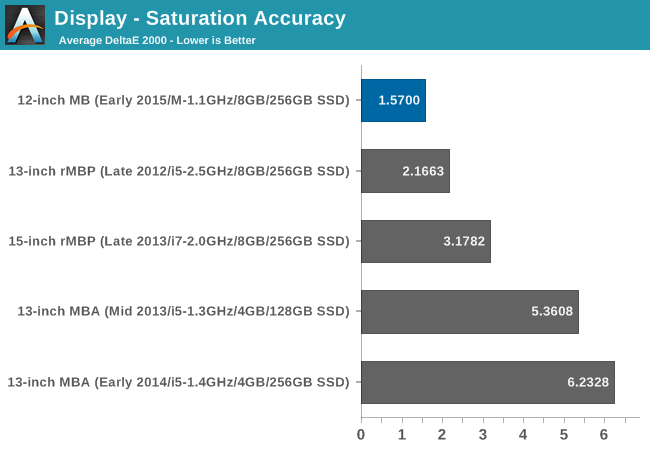
Meanwhile the MacBook’s color saturation accuracy is nothing short of amazing. Here it beats even the rMBPs, not to mention easily surpassing the MBAs and their TN displays. Even though it’s a bit too red, the MacBook is close enough for great out of the box performance.
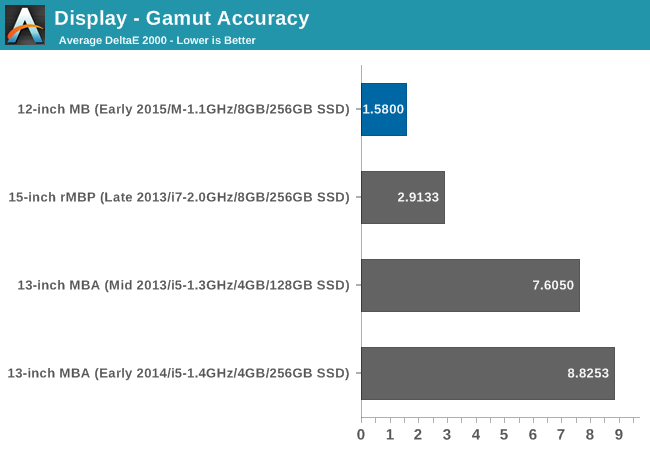
Similar to saturation accuracy, gamut accuracy is well in the MacBook’s favor. Once again even the rMBP we have on file is well behind, never mind the MBAs.
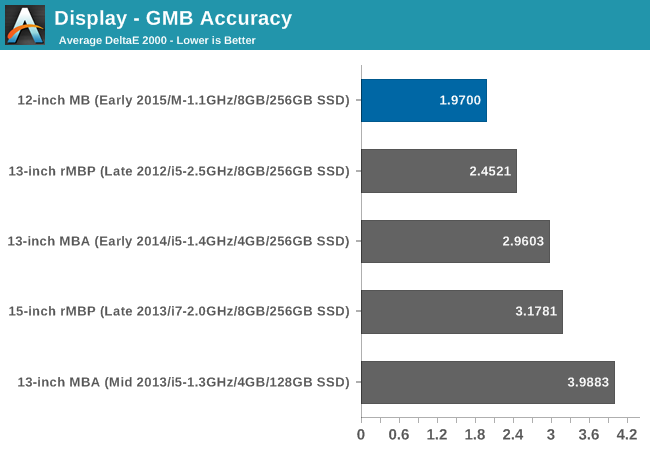
Finally, the GMB color checker results continue to be well in the MacBook’s favor. The error of 1.97 is once more better than any other Mac we have tested, and overall a great place to be at, especially for out of the box performance. Overall this reiterates the fact that while the MacBook may not be classified as a Pro, it without a doubt packs a Pro display.
With post calibration it’s almost certain we could get the errors on the MacBook down to below 1.0. But with such great out of the box performance it’s difficult to complain. Other than for color-critical work, this is a near-perfect reproduction of the sRGB color space.


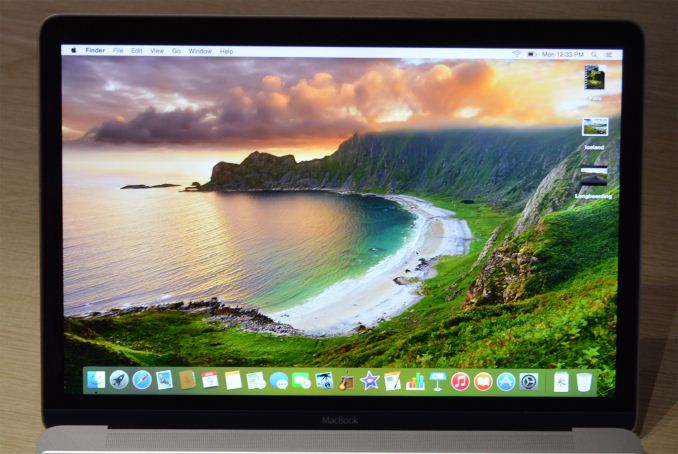
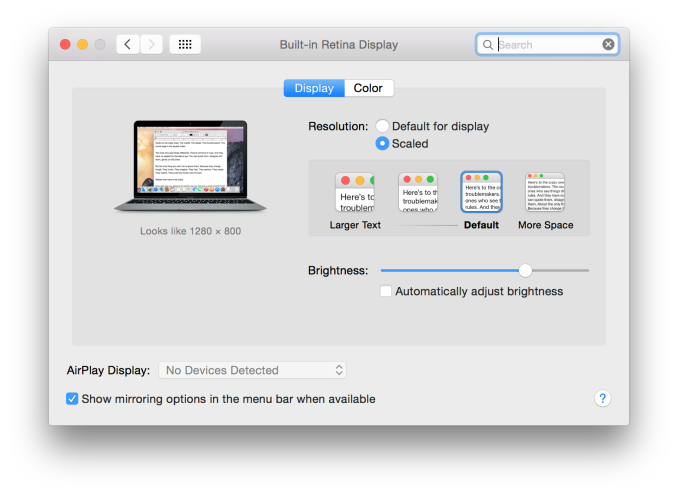
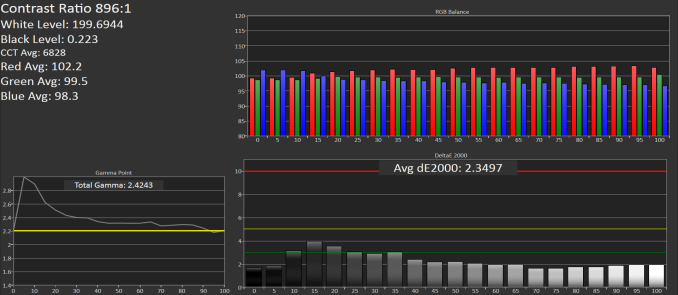
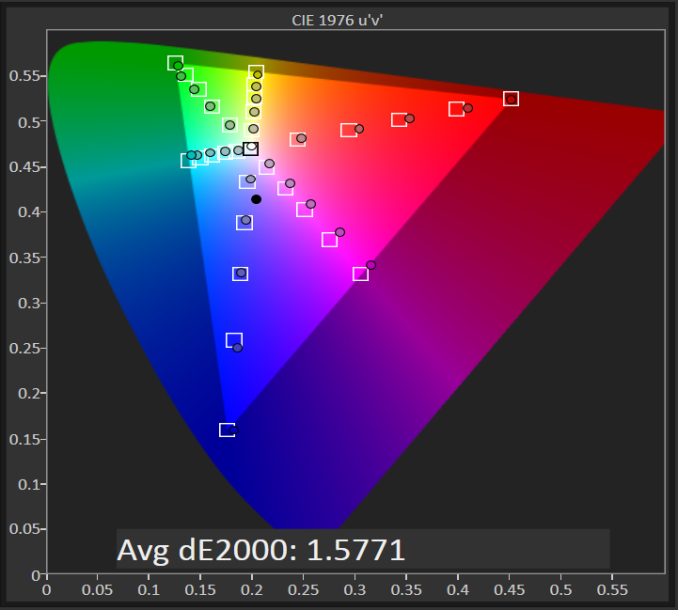










354 Comments
View All Comments
RT81 - Wednesday, April 15, 2015 - link
The presence of "no touch screen" complaints, as few as they are, is interesting. There's a whole demographic of Mac users (creative professionals, mostly) that are sweating bullets about the possibility of iOS and OS X converging. A touch screen Mac would probably give them a heart attack.Apple has said they don't have any intention of doing that. It didn't go over so well for Microsoft, but who knows. It wouldn't be the first time Apple has said "we'll never do that" but what they really mean is "we'll never do that until we can do it at the standard of quality we want".
senzen - Wednesday, April 15, 2015 - link
Very good, thorough review. As soon as I sold my 2010 MBA 11 to get an MBPr Pro I missed the smaller size and weight, but I wanted a retina display for when I travel and take photos, so the new Macbook ticks all the boxes. My doubt was the performance, but seeing it apparently does at least as well as the first i5 MBAs is reassuring, I don't need more. I'm still tempted to wait for the second generation, which is reinforced by Apple's inability to actually show these in stores. I wonder if the upgrade to the faster (less slow) processor is worth it.Malac - Wednesday, April 15, 2015 - link
I think two tests that I feel would be very interesting are missing:- Remote Desktop streaming
- Virtual Machine Benchmark
I sometimes play PC games streamed from my powerful desktop to my MacBook Air using Microsoft Remote Desktop or Steam. While this works well, the air does get hot sometimes and I hear the fans. How would the MacBook handle such a load?
And how well does a VM work? Lets say VirtualBox + Linux with a graphical frontend?
Ryan Smith - Wednesday, April 15, 2015 - link
Steam in-home streaming uses H.264, so all the heavy lifting should be done by the video decode block, and the end result not much harder than decoding any other 1080p60 H.264 stream.jeffry - Wednesday, April 15, 2015 - link
Nice. Apples "new" butterfly mech. Thats a copy of how the japs have done it years ago in their Sony Vaio SZ Series notebooks...nerd1 - Wednesday, April 15, 2015 - link
Why mention tablet laptop crossover at all? This laptop is not convertible, not derachable, lacks touchscreen or pen. It is by all means just a thin, lightweight laptop (with LESS endurance and power)Ryan Smith - Wednesday, April 15, 2015 - link
The short answer is because internally it's built like a tablet, not a laptop, and that's the primary point I'm trying to make when discussing its construction.nerd1 - Thursday, April 16, 2015 - link
Built like a tablet? What does it mean at all? How does crippled laptop becomes a tablet?Some tablets are more powerful and expandable than MBA 11" (which is a LAPTOP).
nerd1 - Wednesday, April 15, 2015 - link
Oh and samsung released very similiar laptop (core m, 1600p display, 2lbs) with usb, sd slot and separate power jack months before.solipsism - Wednesday, April 15, 2015 - link
1) I think it's both odd and wrong that Ryan Smith would repeatedly try to state this is some sort of Mac-iPad hybrid. It doesn't run iOS, it has an attached keyboard and trackpad, it doesn't even have a touchscreen display (something increasingly more common on notebooks). This is a notebook computer designed to run a desktop-grade OS.2) This is not a netbook. Even if we ignore all the low-quality, budget-focused design constraints that that made the netbook really only good* for surfing the "net", this machine has a CPU that costs more than the average notebook and that is magnitudes more powerful with a similar power envelope. If it's to be classed at anything it is an Ultrabook, sans the official branding.
3) Apple's USB-C adapters aren't that pricey. If one wants, they can buy the adapters that Google sells for their new Chromebook Pixel or wait for other vendors (my favourite is Monoprice) to offer up their own solutions since this is, after all, USB. There will also likely be 3rd-party external displays from everyone(?) that will use a single USB-C port for both charging the device and pushing data, which will have their own variety of built-in hubs for those wanting an external display which makes the majority of these complaints for a nascent standard just coming to market moot.
4) People are lamenting the loss of MagSafe, but is that really feasible with how small the 3rd(?) MagSafe adapter would have gotten for this machine? Also, if it's designed to be used remotely and designed to be almost always used without cabled peripherals, is it really an issue for its intended market? Personally, I love how the Chromebook Pixel has USB-C on each side and how either can charge the device. I've moved an entire office around because of how the plug on the left-hand side was causing it to wear out after about 6 months due to being plugged into the wall at the right. This was never an issue when PVC was still included in cables (speculative cause and effect). Hopefully when the MBPs get this feature it will be on both sides.
5) So why bring back the MB and not simply call it the MBA (not unlike how they keep the non-Retina MBPs and came out with the new Retina MBPs with a new design)? Eventually I would like to see the MBA get the exact same external HW design and components (i.e.: Retina display with the same 12" design only) but running Mac OS X — or a Mac OS X-like OS — on Apple's A-series chip. This could allow Apple to move their "PC" sales to even lower end of the market by being able to drop the cost by a few hundred dollars whilst still being able to have a machine that performs well. I do think the A-series chip may need some additional revisions (but we really don't know what is possible with their bespoke design) and for Mac OS X to get another housecleaning, perhaps even rewritten in Swift.
* Calling a netbook good at anything is a stretch, especially when even Adobe Flash would stutter on even 480p video due to its inept HW.